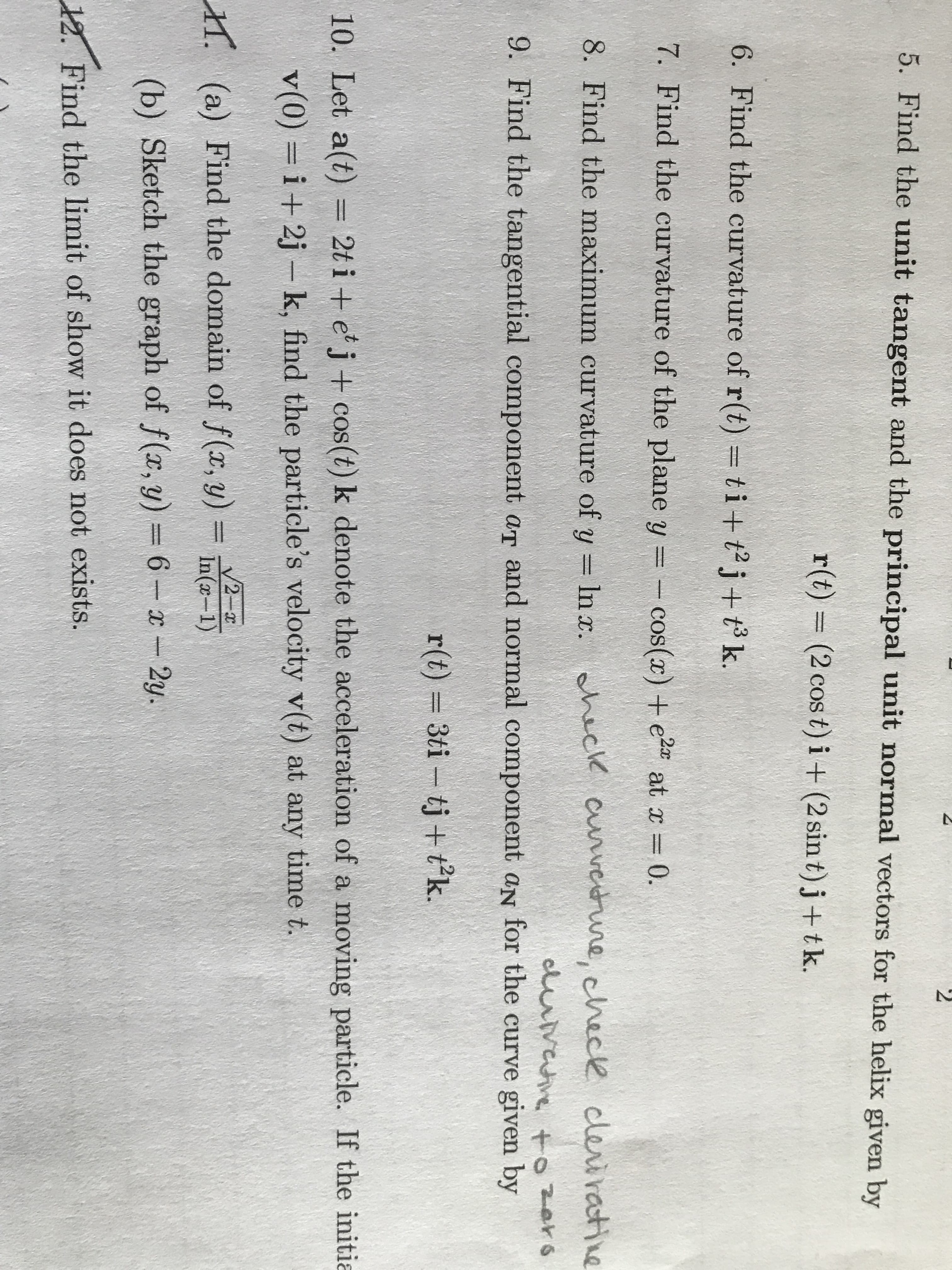$2 5. Find the unit tangent and the principal unit normal vectors for the helix given by r(t) = (2 cos t) i + (2 sin t) j+ tk. 6. Find the curvature of r(t)= ti+t2j + t k. 7. Find the curvature of the plane y = cos() +e 2x at r 0. 8. Find the maximum curvature of y In . ck aveerune, chece cleiractie eluvahe +ozors 9. Find the tangential component ar and normal component an for the curve given by r(t) 3ti tj+ tk. 10. Let a(t) = 2t i + e' j + cos(t) k denote the acceleration of a moving particle. If the initia v(0) = i+ 2j-k, find the particle's velocity v(t) at any time t. V2 x (a) Find the domain of f(x, y)=In(-1) (b) Sketch the graph of f(x, y) = 6 -2y 12. Find the limit of show it does not exists.
$2 5. Find the unit tangent and the principal unit normal vectors for the helix given by r(t) = (2 cos t) i + (2 sin t) j+ tk. 6. Find the curvature of r(t)= ti+t2j + t k. 7. Find the curvature of the plane y = cos() +e 2x at r 0. 8. Find the maximum curvature of y In . ck aveerune, chece cleiractie eluvahe +ozors 9. Find the tangential component ar and normal component an for the curve given by r(t) 3ti tj+ tk. 10. Let a(t) = 2t i + e' j + cos(t) k denote the acceleration of a moving particle. If the initia v(0) = i+ 2j-k, find the particle's velocity v(t) at any time t. V2 x (a) Find the domain of f(x, y)=In(-1) (b) Sketch the graph of f(x, y) = 6 -2y 12. Find the limit of show it does not exists.
Algebra & Trigonometry with Analytic Geometry
13th Edition
ISBN:9781133382119
Author:Swokowski
Publisher:Swokowski
Chapter11: Topics From Analytic Geometry
Section11.4: Plane Curves And Parametric Equations
Problem 33E
Related questions
Question
Help with #5

Transcribed Image Text:$2
5. Find the unit tangent and the principal unit normal vectors for the helix given by
r(t)
= (2 cos t) i + (2 sin t) j+ tk.
6. Find the curvature of r(t)= ti+t2j + t k.
7. Find the curvature of the plane y =
cos() +e
2x
at r 0.
8. Find the maximum curvature of y In . ck aveerune, chece cleiractie
eluvahe +ozors
9. Find the tangential component ar and normal component an for the curve given by
r(t) 3ti tj+ tk.
10. Let a(t) = 2t i + e' j + cos(t) k denote the acceleration of a moving particle. If the initia
v(0) = i+ 2j-k, find the particle's velocity v(t) at any time t.
V2 x
(a) Find the domain of f(x, y)=In(-1)
(b) Sketch the graph of f(x, y) = 6 -2y
12. Find the limit of show it does not exists.
Expert Solution
This question has been solved!
Explore an expertly crafted, step-by-step solution for a thorough understanding of key concepts.
This is a popular solution!
Trending now
This is a popular solution!
Step by step
Solved in 5 steps with 4 images

Knowledge Booster
Learn more about
Need a deep-dive on the concept behind this application? Look no further. Learn more about this topic, calculus and related others by exploring similar questions and additional content below.Recommended textbooks for you

Algebra & Trigonometry with Analytic Geometry
Algebra
ISBN:
9781133382119
Author:
Swokowski
Publisher:
Cengage

Algebra & Trigonometry with Analytic Geometry
Algebra
ISBN:
9781133382119
Author:
Swokowski
Publisher:
Cengage